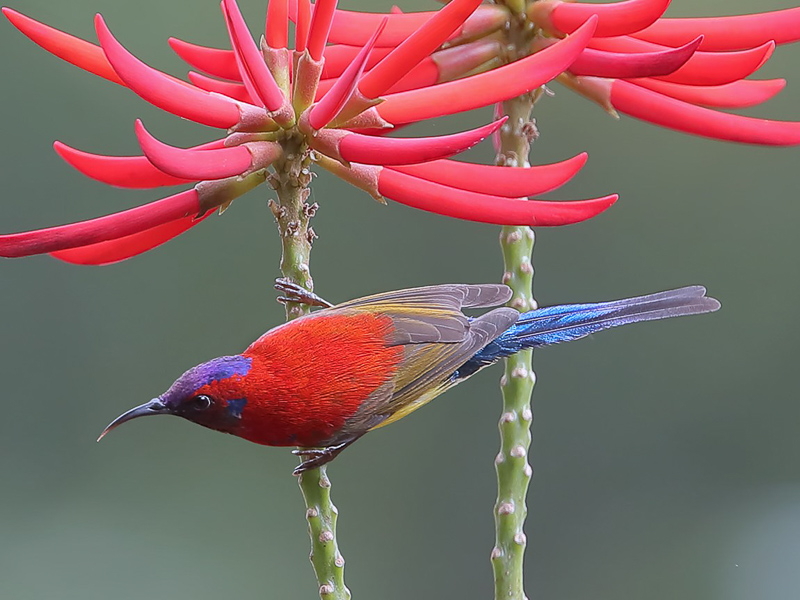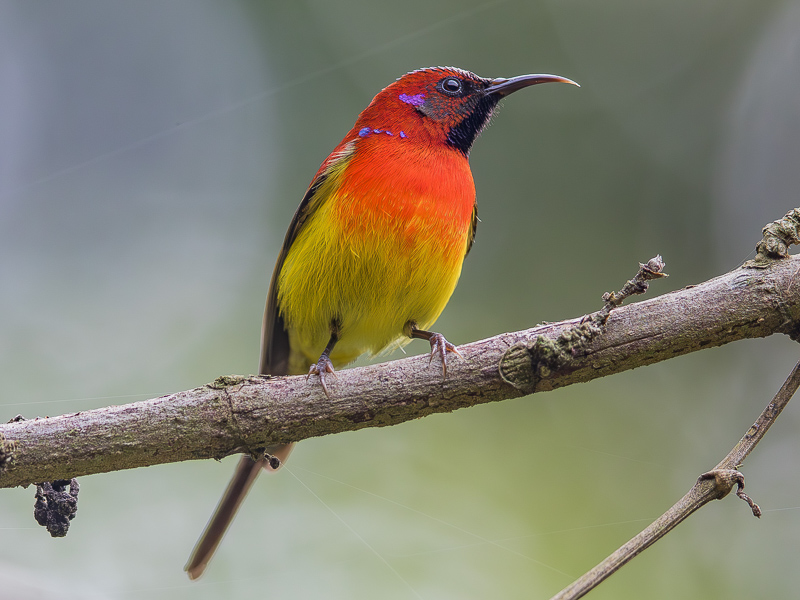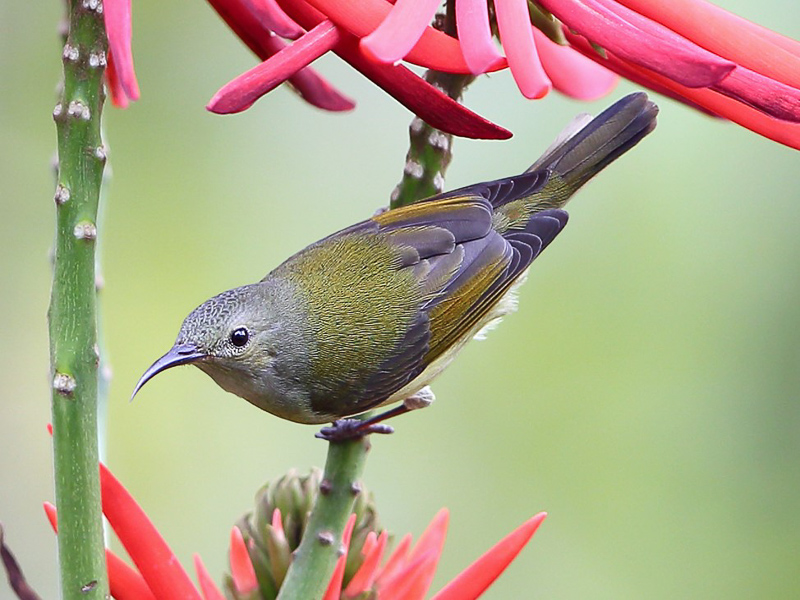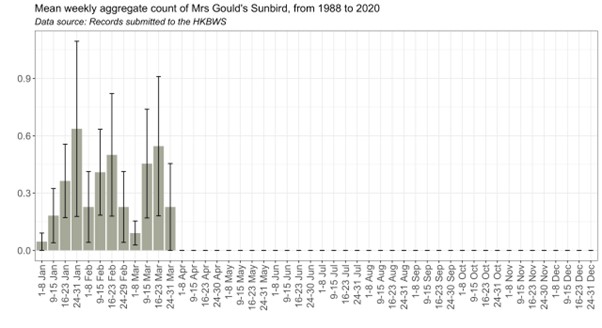Mrs Gould’s Sunbird Aethopyga gouldiae 藍喉太陽鳥
Category I. Scarce winter visitor to forest.
IDENTIFICATION

Feb. 2020, Michelle and Peter Wong. Adult male.
Adult male has red mantle, scapulars and lesser and median coverts, yellow lower back and dark blue rump, uppertail coverts and tail. The greater coverts and remiges are broadly edge olive green. The tail is graduated, with very long central tail feathers.

Feb. 2020, Matthew Kwan. Adult male.
The red of the upperparts extends to the face and across the chest. The crown, nape, lores and throat are dark purplish-blue, . The flanks and belly to vent are yellow.

Mar. 2014, Michelle and Peter Wong. Female.
The female has a rather greyish head and mantle, whitish throat, yellow underparts and rump, greenish mantle and tail and yellowish edges to the remiges. Eclipse males have varying amounts of red present.
VOCALISATIONS
Typical calls are higher in pitch and slightly purer than those of Fork-tailed Sunbird.
The song is very simple, a repeated slightly wheezy modulated note.
DISTRIBUTION & HABITAT PREFERENCE
All records have occurred in areas of closed-canopy woodland. About 60% of records have occurred in Tai Po Kau and 20% at KFBG, while the remainder have been in scattered wooded sites such as Shing Mun / Lead Mine Pass, Shek Kong, Tai Lam CP, Chai Wan.
OCCURRENCE
There were three records of Mrs Gould’s Sunbird from 24 February 1988 to 21 March 1990, the first from 24 February to 2 March (Young 1989). In view of the species not considered to be migratory and the appearance of the birds such as to suggest some kind of plumage damage arising, it was considered the likelihood of their being ex-captive was high, the species was listed in the then Category E (equivalent to Category III). In retrospect, however, and in view of the pattern of records subsequently, it would appear that these records involved birds that arrived naturally. It is likely that a perception of cage damage was simply the result of males being in eclipse plumage in which the colours appear patchy and the head dull brown.
Subsequently, singles were recorded at three sites during 1-12 March 1998. However, there were no further records until 22 January 2005, which marked the beginning of an occurrence pattern that is considered normal today. All records have occurred in the period 5 January to 27 March, though there is no clear peak period of occurrence (Figure 1). The lack of records in the first half of the winter is interesting and suggests that occurrence here is a response to food availability further north.
The highest count is of seven birds at Tai Po Kau on 18 February 2020, though most records are of one or two. Males predominate, but this is no doubt due to their being very obvious.
BEHAVIOUR, FORAGING & DIET
Typically active in the manner of sunbirds. Recorded feeding at the flowers of Erythrina speciosa on nectar, insects and spiders, and on Calliandra haematocephala (Barretto and Barretto 2020).
RANGE & SYSTEMATICS
Breeding range encompasses the southern slopes of the Himalayas east through Nepal, Bhutan and southern Tibet to western China and south to northern and eastern parts of Indochina; winter visitor to northern Thailand (Cheke and Mann 2020). In China it breeds from southern Tibet east through southwestern provinces as far as Shaanxi and Guangxi. Occurs in the non-breeding season in southern coastal provinces as far as Fujian (Liu and Chen 2020).
A. g. dabryii occurs in north Indochina and central and south China, including HK. Three other subspecies are recognised.
CONSERVATION STATUS
IUCN: Least Concern. Population trend stable.
Figure 1
Figure 1.

Barretto, K. and R. Barretto (2020). Bird of the Month. Mrs Gould's Sunbird Aethopyga gouldiae (dabryii). Hong Kong Gardening Society Newsletter, Feb. 2020.
Cheke, R. and C. Mann (2020). Mrs. Gould's Sunbird (Aethopyga gouldiae), version 1.0. In Birds of the World (J. del Hoyo, A. Elliott, J. Sargatal, D. A. Christie, and E. de Juana, Editors). Cornell Lab of Ornithology, Ithaca, NY, USA. https://doi.org/10.2173/bow.gousun1.01
Liu, Y. and Y. H. Chen (eds) (2020). The CNG Field Guide to the Birds of China (in Chinese). Hunan Science and Technology Publication House, Changsha.
Young, W. (1989). Gould’s Sunbird in Tai Po Kau: a new record for Hong Kong. Hong Kong Bird Report 1988: 82-83.

